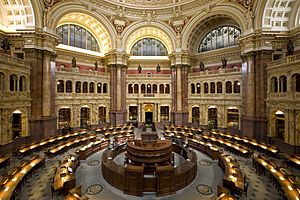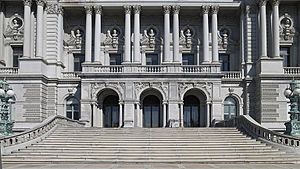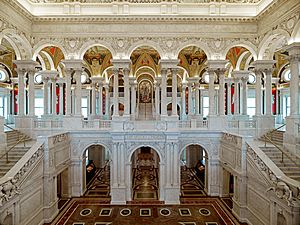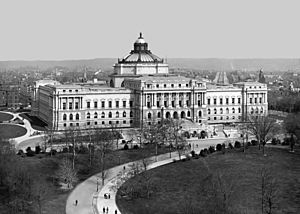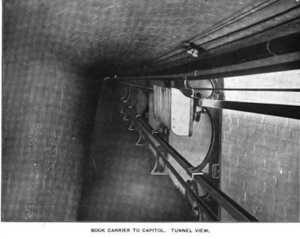Thomas Jefferson Building facts for kids
Quick facts for kids Thomas Jefferson Building |
|
|---|---|
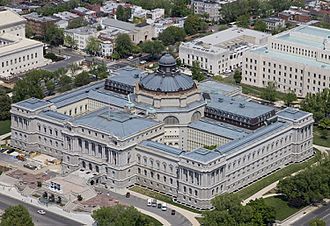
The Thomas Jefferson Building at the Library of Congress
|
|
| General information | |
| Architectural style | Beaux-Arts |
| Town or city | Washington, D.C. |
| Country | United States |
| Construction started | 1890 |
| Completed | 1897 |
| Design and construction | |
| Architect |
|
The Thomas Jefferson Building is the oldest of the four buildings that make up the Library of Congress in the United States. It was built between 1890 and 1897. This amazing building was first called the Library of Congress Building. You can find it in Washington, D.C., on First Street SE, between Independence Avenue and East Capitol Street.
The building is famous for its beautiful Beaux-Arts style. This means it has a classic look on the outside, called a facade, and a very fancy inside. Many people worked on its design and building over the years. The main architects included Paul J. Pelz, John L. Smithmeyer, and later Edward Pearce Casey. In 1965, the building was named a National Historic Landmark, which means it's a very important historical place.
Contents
Designing the Thomas Jefferson Building
The story of designing the Library of Congress building began in 1873. Architects John L. Smithmeyer and Paul J. Pelz won a contest for the building's plans. However, the project was delayed for a long time because of discussions in Congress. Finally, in 1886, they voted to start building.
In 1888, Smithmeyer was no longer part of the project, and Pelz became the main architect. But Pelz was also replaced in 1892 by Edward Pearce Casey. Casey's father, Thomas Lincoln Casey Sr., was in charge of the building's construction at the time.
While Smithmeyer helped get the project started, Pelz did most of the main design work. He oversaw the building's exterior, which is the outside part. Casey then finished the inside of the building. He also made sure all the unique art and decorations were just right. The Library opened its doors to the public in 1897. The final touches were completed in 1898.
Art and Decorations Inside
The Thomas Jefferson Building has some of the most beautiful public interiors in the United States. Many American sculptors and painters from a time called the "American Renaissance" created art for the building. This art shows the progress of civilization and important people. The Librarian of Congress, Ainsworth Rand Spofford, often helped decide what art would be included.
The building's main part is similar to the Palais Garnier in Paris. Both buildings show off their country's culture and pride using the Beaux-Arts style. This style was very popular after the World's Columbian Exposition in Chicago in 1893.
On the outside of the building, you can see sculptures of different types of people from around the world. These are placed above the windows on the main floor. The front entrance, which faces the U.S. Capitol, has nine busts (sculptures of heads and shoulders) of famous men. These were chosen by Ainsworth Rand Spofford to represent important figures of that time.
From left to right, as you look at the building, they are:
- Demosthenes
- Ralph Waldo Emerson
- Washington Irving
- Johann Wolfgang von Goethe
- Benjamin Franklin
- Thomas Babington Macaulay
- Nathaniel Hawthorne
- Sir Walter Scott
- Dante Alighieri
The sculptors who created these busts were Herbert Adams, Jonathan Scott Hartley, and Frederick W. Ruckstull.
Near the entrance, you'll also find The Court of Neptune Fountain. This fountain reminds some people of the famous Trevi Fountain in Rome. Roland Hinton Perry was the sculptor for this beautiful fountain. The building's copper dome was once covered in gold. Some people thought it looked too much like the dome of the Capitol Building.
History of the Library Building
The Library of Congress needed more space for its growing collection of books and other items. So, the Librarian of Congress, Ainsworth Rand Spofford, suggested to the Congress that a new building be built. Before this, the Library was located in a part of the Capitol Building.
A new building was needed for a few reasons. First, Congress itself was growing and needed more room. Second, a new Copyright Law was passed in 1870. This law said that anyone applying for a copyright had to send two copies of their work to the Library. This meant the Library received a huge number of books, pamphlets, maps, music, and photographs. Spofford played a big part in getting this law passed.
After Congress approved the building in 1886, it took eleven years to finish. The building opened to the public on November 1, 1897. People loved it right away and saw it as an important national landmark. On June 13, 1980, the building's name was changed to honor former U.S. President Thomas Jefferson. Jefferson was very important in starting the Library in 1800. He even offered to sell his own large book collection to Congress in September 1814. This was after the British had burned the Capitol during the War of 1812.
Book Tunnel to the Capitol
Before the early 2000s, the Jefferson Building was connected to the Capitol Building by a special tunnel. This tunnel had an electric "book conveying apparatus." It could move books between the two buildings very quickly, at 600 feet per minute. Part of this book tunnel was later removed to make space for the underground Capitol Visitor Center, which opened in 2008.
Coolidge Auditorium for Music
The Elizabeth Sprague Coolidge Auditorium opened in October 1925. It has hosted over 2,000 concerts. Most of these are classical chamber music, but sometimes jazz, folk music, and special shows are also performed. Some concerts use the Library's large collection of musical instruments and old music papers. Many of these performances are free for the public to enjoy.
Elizabeth Sprague Coolidge was a rich person who supported the arts. She was not related to Calvin Coolidge, who happened to be the President of the United States when the auditorium was built.
Images for kids
-
Elihu Vedder, Minerva of Peace, 1896.
See also
 In Spanish: Edificio Thomas Jefferson para niños
In Spanish: Edificio Thomas Jefferson para niños


